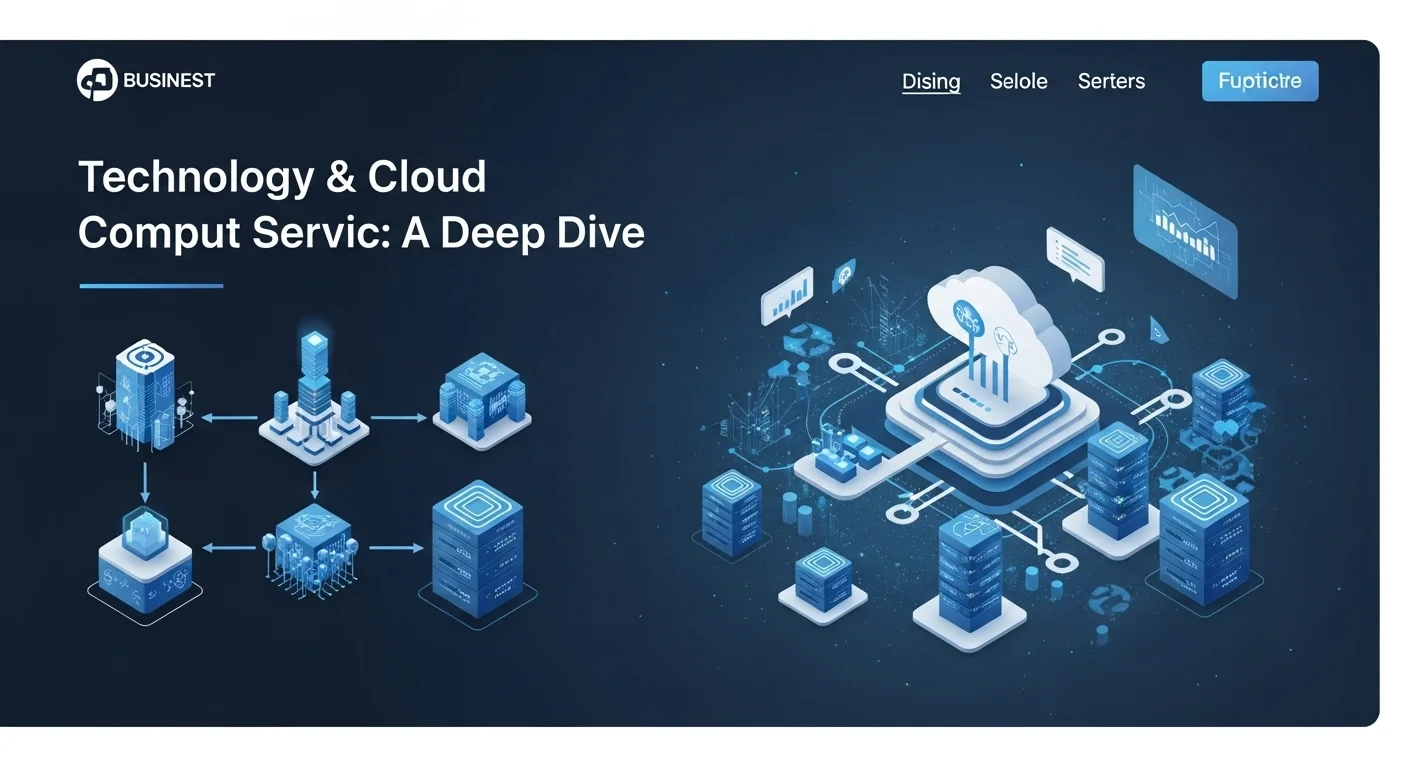Your 2025 Playbook: Key Technologies for a Thriving Small Business

Executive Summary
In my years of helping small businesses grow, I've seen one thing change the game more than anything else: technology. It’s no longer just for the big corporations. Today, technology is the great equalizer, giving entrepreneurs in bustling cities and quiet small towns the power to build something truly special. This guide is my personal playbook, built from experience, to help you understand and use the tech that matters. We'll cut through the jargon and talk about how tools like Artificial Intelligence (AI), cloud computing, and solid cybersecurity can become your secret weapons. We're going to explore real-world ideas and strategies you can use right now to build a more efficient, secure, and successful business. Think of this as a roadmap to navigate the digital world, helping you turn your vision into a reality that's built to last.
Table of Contents
Table of Contents
- What is a Thriving Small Business in the Digital Age?
- The Tech Trio: AI, Cloud, and Cybersecurity
- Putting It All Together: Real-World Applications
What is a Thriving Small Business in the Digital Age?
The idea of a 'successful small business' has completely transformed. I remember a time when success was measured by how many people walked through your front door. Today, it’s a whole different ballgame. Technology has torn down the old walls, allowing a small shop to sell to customers across the globe and a solo entrepreneur to compete with industry giants. To be a successful small business now means being smart with technology. It's about using digital tools to work smarter, not harder; to connect with customers in meaningful ways; and to open up doors to growth you never thought possible. It’s about being nimble, making decisions based on data, and building a secure foundation in our hyper-connected world. Technology isn't just a tool anymore—it's the bedrock. Things like cloud services, AI, and cybersecurity are no longer expensive toys for big companies. They are affordable, accessible, and absolutely essential for anyone looking to build a resilient business.
In this first section, we'll dive into this crucial relationship between tech and modern small business. I've seen some of the most innovative business ideas come to life simply by finding a manual process and applying a tech solution. Think of an e-commerce store that uses AI to suggest products you’ll love, or a local plumber who manages all their appointments seamlessly with cloud software. These ventures have technology at their very core. Looking ahead to 2025, the business ideas that will truly take off won't just use tech—they'll be born from it, with a digital-first approach from day one. This shift is powerful, especially for businesses in smaller communities. I’ve worked with many small-town businesses that have used technology to reach a global audience while keeping their local heart and soul, proving that great ideas and a smart digital strategy know no geographical limits.
The Tech Trio: AI, Cloud, and Cybersecurity
To really get a handle on building a tech-savvy business, you need to understand three core pillars: Artificial Intelligence, Cloud Computing, and Cybersecurity. I call them the 'tech trio' because they work together to create a business that's efficient, flexible, and trustworthy.
Artificial Intelligence (AI): Your Efficiency Engine
If there's one technology that feels like a superpower for small businesses, it's AI. It's not about robots; it's about practical tools that automate tedious tasks, uncover hidden insights in your data, and help you create amazing customer experiences. For a small team, this is a game-changer. Imagine AI handling your data entry, scheduling appointments, or answering basic customer questions with a chatbot. Suddenly, you and your team have more time to focus on strategy, building relationships, and the creative work that grows your business. I've seen AI analytics tools help business owners understand sales trends and customer behavior in ways that used to require a whole team of analysts. Many of today's best business ideas use AI in clever ways. For example, a monthly subscription box service can use AI to tailor its products to each customer's tastes, creating a level of personalization that builds incredible loyalty.
Cloud Computing: The Foundation of Flexibility
Cloud computing has been a revolution. It gives small businesses access to the kind of powerful servers, storage, and software that used to cost a fortune, all on a simple pay-as-you-go basis. This means you don't need a massive upfront investment in hardware. This scalability is a key ingredient for new business ideas. An online store, for instance, can start on a small, affordable cloud plan and effortlessly scale up as it gets more popular, all without the website crashing. Cloud-based software, known as SaaS (Software as a Service), gives you powerful tools for accounting (like QuickBooks Online), customer management (like HubSpot), and project management (like Trello). This accessibility helps great ideas get off the ground fast with very little cash. The cloud is also what makes remote work possible, allowing a business in a small town to hire the best talent from anywhere and serve a worldwide market.
Cybersecurity: Your Shield of Trust
In our digital world, your data is one of your most precious assets, and protecting it is non-negotiable. I can't stress this enough: cybersecurity isn't an optional extra. A single data breach can be devastating, both financially and to your reputation. Small businesses are often targeted because criminals think they're easy prey. The good news is that strong cybersecurity is within reach. It starts with the basics: using strong and unique passwords, turning on multi-factor authentication (MFA), and keeping all your software up to date. It also means using firewalls and quality antivirus software. For any business that handles customer information—from e-commerce sites to service providers—cybersecurity is how you build trust. When customers believe you'll protect their data, they're more likely to do business with you. This trust is vital for everyone, from a tech startup in the city to a family-owned business building its online presence in a small town.
Putting It All Together: Real-World Applications
The real magic happens when these three technologies work in harmony. Let's take a popular idea: a specialized online store. This business would likely run on a cloud platform like Shopify, which is reliable and can handle growth. It would use AI-powered apps to give personalized product recommendations and provide 24/7 support through a chatbot. And all its customer and payment data would be locked down with top-notch security, building that crucial foundation of trust. Or think about a remote IT support agency. They'd use the cloud for their entire operation, from customer tickets to team communication. AI could help analyze support requests to spot common problems, making the team more efficient. And cybersecurity would be paramount, protecting both the agency's and their clients' data. These examples show the clear benefits: you become more efficient, you lower your costs, your customers are happier, you can grow easily, and you're more secure. This is what it means to be a thriving small business today.

A Practical Guide to Business Tech Solutions
Moving from knowing that technology is important to actually putting it to work requires a clear plan. I've walked countless business owners through this process, and it all comes down to a strategic, step-by-step approach. This guide is your roadmap to building a business that's not just technologically equipped, but truly competitive. We’ll look at the specific tools and methods you need, comparing different options so you can make the right choices for your unique venture. The aim here is to empower you to turn your great idea into a reality with a strong digital backbone. We’ll explore how these strategies can be applied to all sorts of business ideas, from the traditional to the cutting-edge. We’ll also look ahead to 2025, focusing on how automation and data will define the next wave of successful businesses. And remember, these principles work everywhere—they can help a small-town business build a global presence.
Step 1: Building Your Digital Foundation - The Tech Stack
Every modern business runs on a 'tech stack'—it's simply the collection of software and tools that power your operations. I like to think of it as the foundation and framework of a house. Choosing the right materials is the most important first step.
Core Infrastructure: Your Digital Home Base
Your business needs a digital address (a domain name) and a place to live (hosting for your website). For almost every small business I've worked with, cloud hosting is the way to go, leaving old-school physical servers in the dust.
- Choosing Your Hosting: If you're just starting out, Shared Hosting (from providers like Bluehost or HostGator) is cheap and easy. As your traffic grows, you'll want to upgrade to a Virtual Private Server (VPS), which gives you more power and control. For websites with a lot of traffic or complex needs, dedicated cloud solutions from giants like Amazon Web Services (AWS), Google Cloud, or Microsoft Azure offer incredible power and scalability.
- Comparing the Big Players: AWS is famous for its massive menu of services, making it great for tech-heavy startups. Google Cloud is a powerhouse for data analysis and AI. Microsoft Azure is a natural fit for businesses already using Microsoft products. For those who want something simpler and more user-friendly, providers like DigitalOcean offer great VPS solutions. Your choice will depend on your budget, your comfort level with tech, and how much you expect to grow.
Business Operations: Your SaaS Toolkit
Software as a Service (SaaS) offers ready-to-use tools for almost every part of your business. Assembling the right toolkit will make you incredibly efficient.
- Productivity & Collaboration: Google Workspace and Microsoft 365 are the gold standard for professional email, cloud storage, and shared documents. For team chat, Slack or Microsoft Teams are essential. And to keep projects on track, tools like Asana, Trello, or Monday.com are lifesavers.
- Customer Relationship Management (CRM): A CRM is the brain of your sales and customer service. I often recommend HubSpot's free CRM as a fantastic starting point. As you grow, you might look to an industry leader like Salesforce. A good CRM is the heart of any customer-focused business, allowing you to understand and communicate with your audience on a personal level.
- Finance & Accounting: Cloud accounting software like QuickBooks Online, Xero, or FreshBooks will save you from headaches by automating invoicing, tracking expenses, and simplifying financial reports.
Step 2: Leveling Up with AI and Automation
Once your foundation is solid, it's time to add the smarts. This is where you layer in AI and automation to gain a real competitive advantage.
Automating Your Workflows
Workflow automation tools like Zapier or Make are like digital glue; they connect your different apps so they can talk to each other. For example, you can set up a simple 'Zap' so that when someone fills out a form on your website, their info is automatically added to your CRM, your team gets a notification in Slack, and the customer gets a welcome email. This eliminates tedious manual work and ensures you never miss a lead.
Using AI for Smarter Marketing & Sales
AI can be your secret marketing weapon.
- Smarter Ads: Platforms like Google and Facebook Ads use powerful AI to get your ads in front of the right people, making your marketing dollars go further.
- Content Creation Help: Generative AI tools like Jasper or Copy.ai can help you beat writer's block by drafting blog posts, social media updates, and emails. You'll still need to add your human touch, but they can be a huge time-saver.
- Predictive Power: More advanced platforms are now using AI to predict which customers are most likely to buy or which might be thinking of leaving. This lets you focus your energy where it will count the most.
AI in Customer Service
AI-powered chatbots from services like Intercom or Tidio can be added to your website to offer customers 24/7 support. They can answer common questions, collect information, and route more complex issues to a human. It's a fantastic way to improve customer satisfaction and free up your team.
Step 3: Protecting Your Assets - A Cybersecurity Plan
As your business becomes more digital, protecting it becomes more critical. A proactive cybersecurity plan isn't optional; it's essential for long-term success.
Essential Security Habits
- Locking the Doors: Insist that everyone on your team uses a password manager (like 1Password or LastPass). Most importantly, turn on multi-factor authentication (MFA), everywhere you can. From my experience, this one step is the single most effective way to block unauthorized access.
- Device Protection: Make sure every company computer and phone is protected with business-grade antivirus software. Always keep your operating systems and apps updated—those updates often contain crucial security patches.
- Network Security: Secure your office Wi-Fi with strong encryption and a password that isn’t 'password123'. If you or your team work remotely, using a Virtual Private Network (VPN) is a must, as it encrypts your connection. A firewall should also be in place to act as a gatekeeper for your network traffic.
Data Backup and Recovery
Always, always back up your important business data. Cloud services usually have backups, but I recommend having your own separate, automated backup solution as well. This way, if you ever face a hardware failure or a cyberattack, you can restore your data and get back to business quickly. This resilience is a hallmark of every truly successful modern business.

Pro Tips for Long-Term Tech Success
Becoming a tech-savvy small business isn't a one-time project; it's a continuous process of learning and improving. Once your core technology is in place, the focus shifts to getting the most out of it and staying ahead of the game. This section is filled with my go-to tips and strategies for refining your operations and creating a better experience for both your team and your customers. These are the practices that I've seen separate the businesses that just get by from the ones that truly excel. They apply whether you're running an established business or launching a brand-new one. For entrepreneurs, mastering these habits is what leads to sustainable growth. As we move toward 2025, a culture of continuous tech improvement will be a defining trait of the most successful ventures, including those thriving in small towns by offering a polished, professional experience.
Best Practices for Managing Your Technology
Having the right tools is only half the battle. How you manage them is what truly counts.
1. Conduct Regular 'Tech Check-ups'
At least once or twice a year, take a good look at your entire tech stack. I advise my clients to ask simple questions: Are we actually using this software? Is it worth the money? Is there a better or cheaper tool out there now? This simple audit helps you cut costs by getting rid of 'software bloat' and ensures your toolkit stays lean and effective.
2. Prioritize Team Training
A powerful tool is worthless if no one knows how to use it. When you bring in new software, invest time in training your team. Most providers offer free webinars and tutorials. I've found that creating a culture where people feel comfortable asking questions and sharing shortcuts makes a huge difference. When your team fully adopts a tool, you get the full return on your investment.
3. Make Decisions with Data, Not Just Your Gut
Your technology is constantly collecting valuable data. Use it! Dive into Google Analytics to see how people find your website. Look at your CRM reports to see who your best customers are. Review your accounting software to manage your cash flow. I always say, 'Trust your gut, but verify with data.' Being able to make quick, informed decisions is a massive advantage for any small business.
4. Have a Cybersecurity 'Fire Drill' Plan
You hope you'll never have a fire, but you still have a fire extinguisher. The same goes for cybersecurity. No system is 100% unbreakable. Create a simple, clear plan for what to do if you have a data breach or cyberattack. Who do you call first? How will you notify customers? How do you restore from your backups? Having this plan ready can turn a potential catastrophe into a manageable problem.
Essential Business Tools I Recommend
Beyond the basics, these are a few tools that I consistently see make a big impact on productivity and customer happiness:
- Internal Communication: Slack is my top choice for team chat. It brings all your communication and notifications from other apps into one organized place.
- Project & Task Management: For visually organizing work, Asana or Trello are fantastic. They make it clear who is doing what and when it's due.
- Customer Support & Engagement: Intercom is excellent for engaging with customers through live chat and automated messages, making your support feel personal and proactive.
- Email Marketing & Automation: For building an audience and nurturing leads, Mailchimp or ConvertKit are powerful and user-friendly.
- Social Media Management: To save time, use Buffer or Hootsuite. You can schedule all your posts in advance and analyze what's working from one spot.
Enhancing the Experience for Employees and Customers
The technology you choose directly affects how your team and your customers feel about your business. A great tech experience can boost morale, productivity, and loyalty.
For Employees: A Frictionless Workplace
Your goal should be to create a work environment where technology feels invisible—it just works. Choose tools that are easy to use and work well together. For example, a Single Sign-On (SSO) solution lets your team access all their apps with one password, which is both convenient and secure. Make sure everyone has reliable equipment and a fast internet connection. When technology doesn't get in the way, your team can focus on doing their best work.
For Customers: A Seamless Journey
Your customers expect things to be easy. Your website needs to be fast and mobile-friendly. Your checkout process should be simple. Your customer support should be helpful and quick to respond. Use your tech to look at the entire customer journey and find any rough spots. For example, if a lot of people are abandoning their shopping carts, maybe your shipping costs are a surprise, or the payment form is confusing. Fixing these small points of friction makes for happier customers and more sales.
High-Quality External Resource
To stay on top of how technology is changing the business world, I regularly check the Gartner for Small Business portal. Gartner is a top research firm, and their small business section offers expert insights and practical advice specifically for smaller companies. It's a goldmine for understanding new trends and making smart tech decisions.
By putting these advanced strategies into practice, you can elevate your business from one that just uses technology to one that masters it. From my experience, that mastery is the final ingredient for building a resilient, efficient, and beloved business that will thrive for years to come.
Expert Reviews & Testimonials
Sarah Johnson, Shop Owner ⭐⭐⭐⭐
As a small shop owner, this was a great starting point. I especially found the breakdown of different cloud hosting options useful, though I'd love to see a case study of a retail business in a future article.
Mike Chen, IT Consultant ⭐⭐⭐⭐⭐
A solid, well-structured guide. I consult for small businesses, and the way you explained the synergy between AI, cloud, and cybersecurity is something I'll be sharing with my clients. It simplifies complex topics without dumbing them down.
Emma Davis, Tech Entrepreneur ⭐⭐⭐⭐⭐
Absolutely fantastic article! As someone deep in the tech world, I'm impressed by how accessible and actionable this is. The section on building a security incident response plan is something too many small businesses overlook. This is a must-read!



